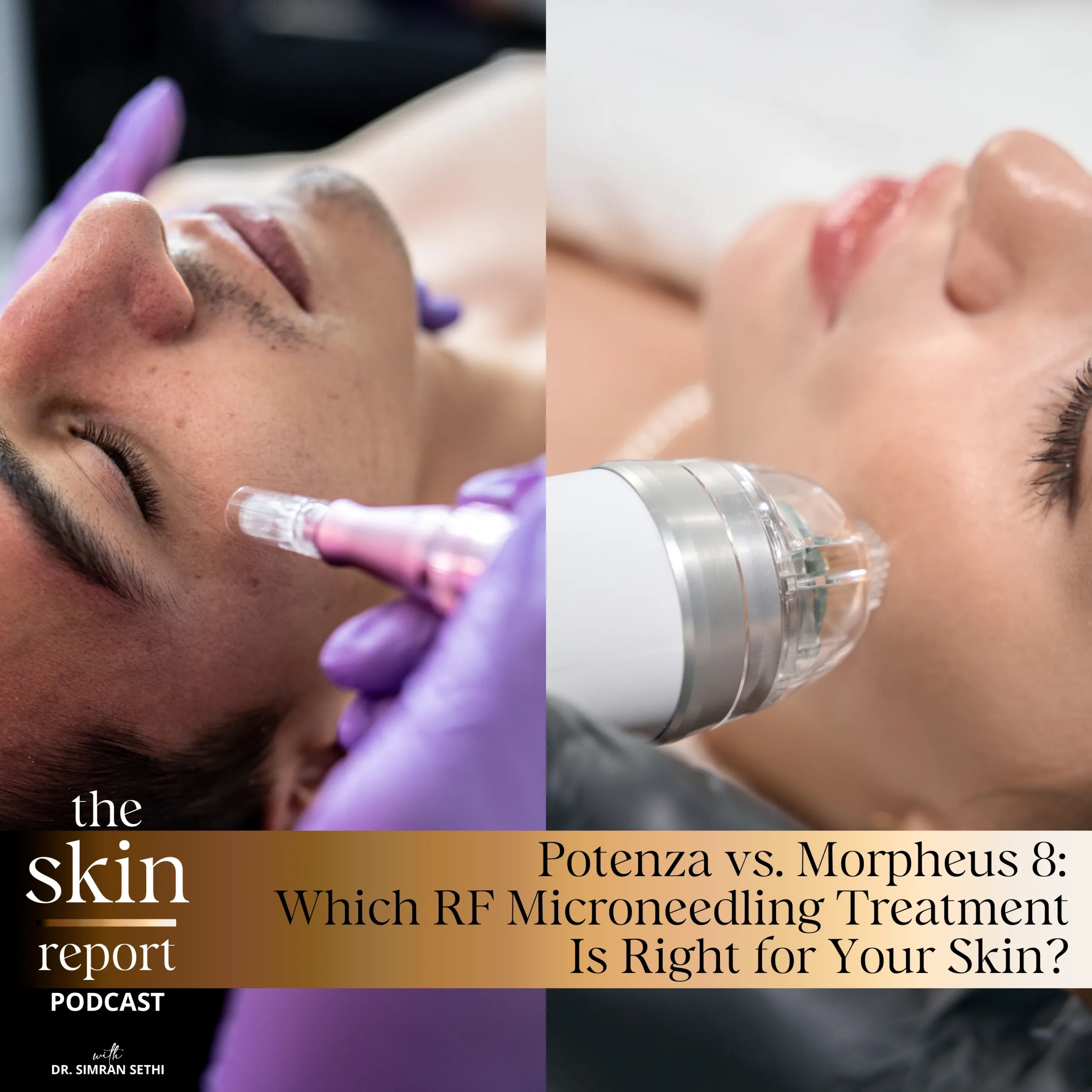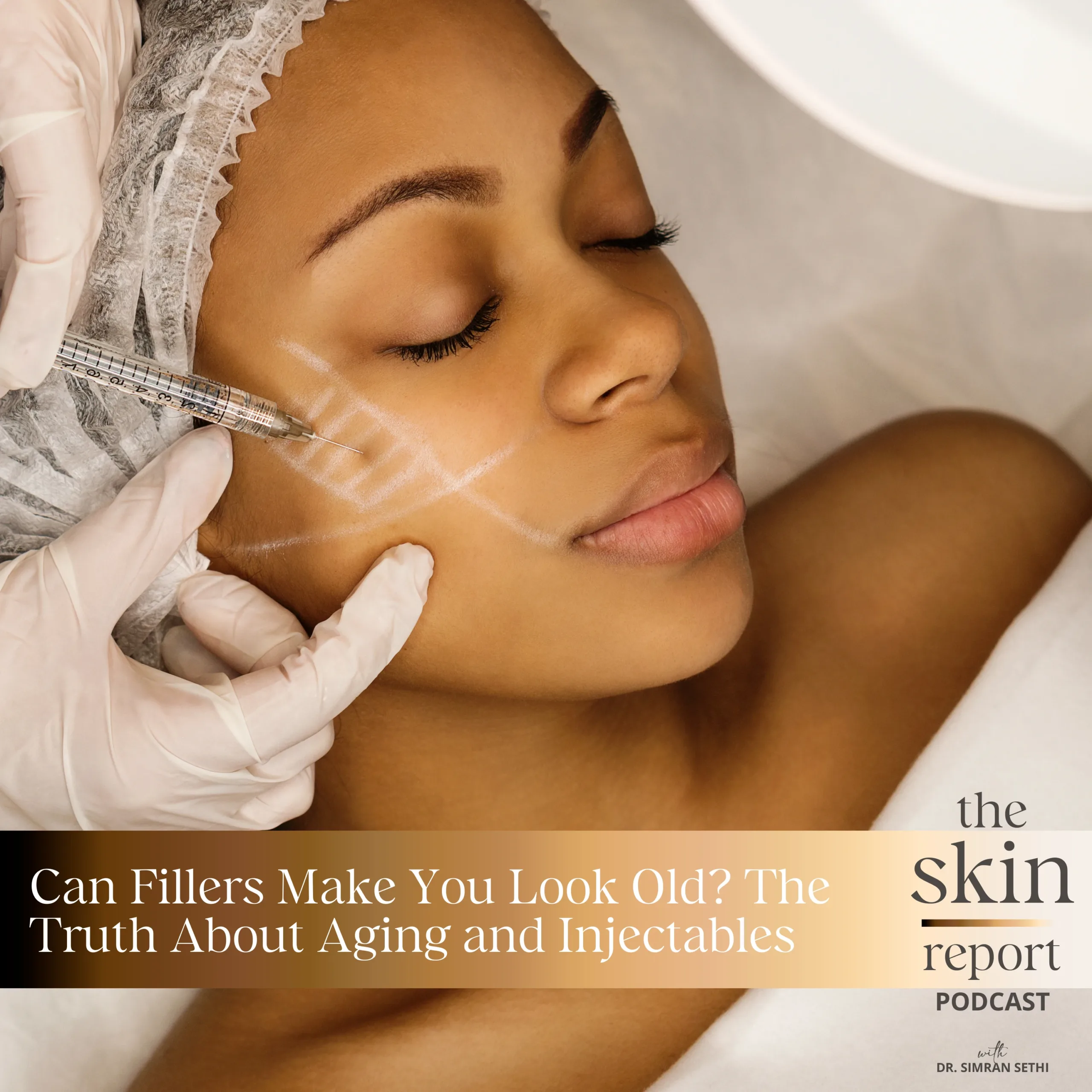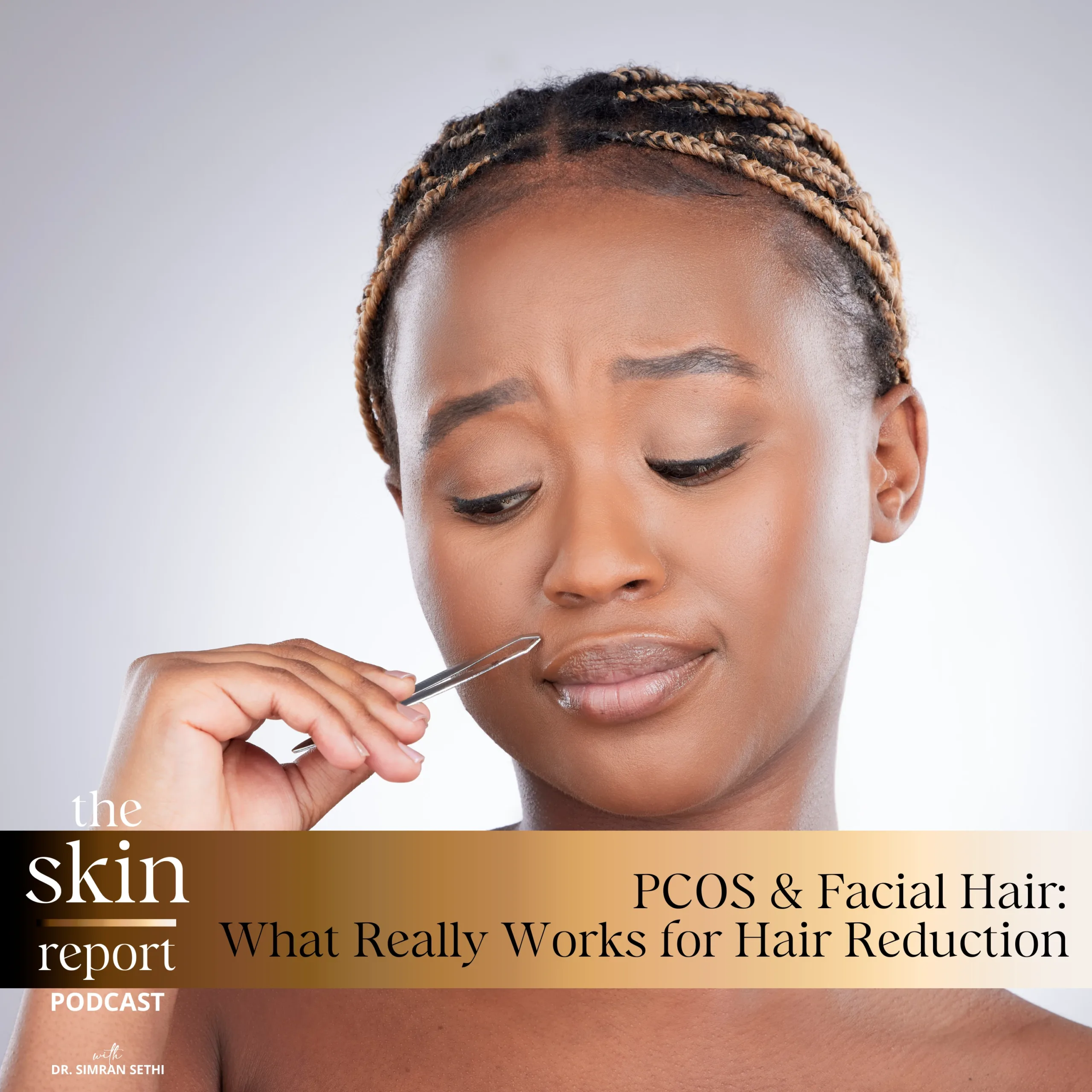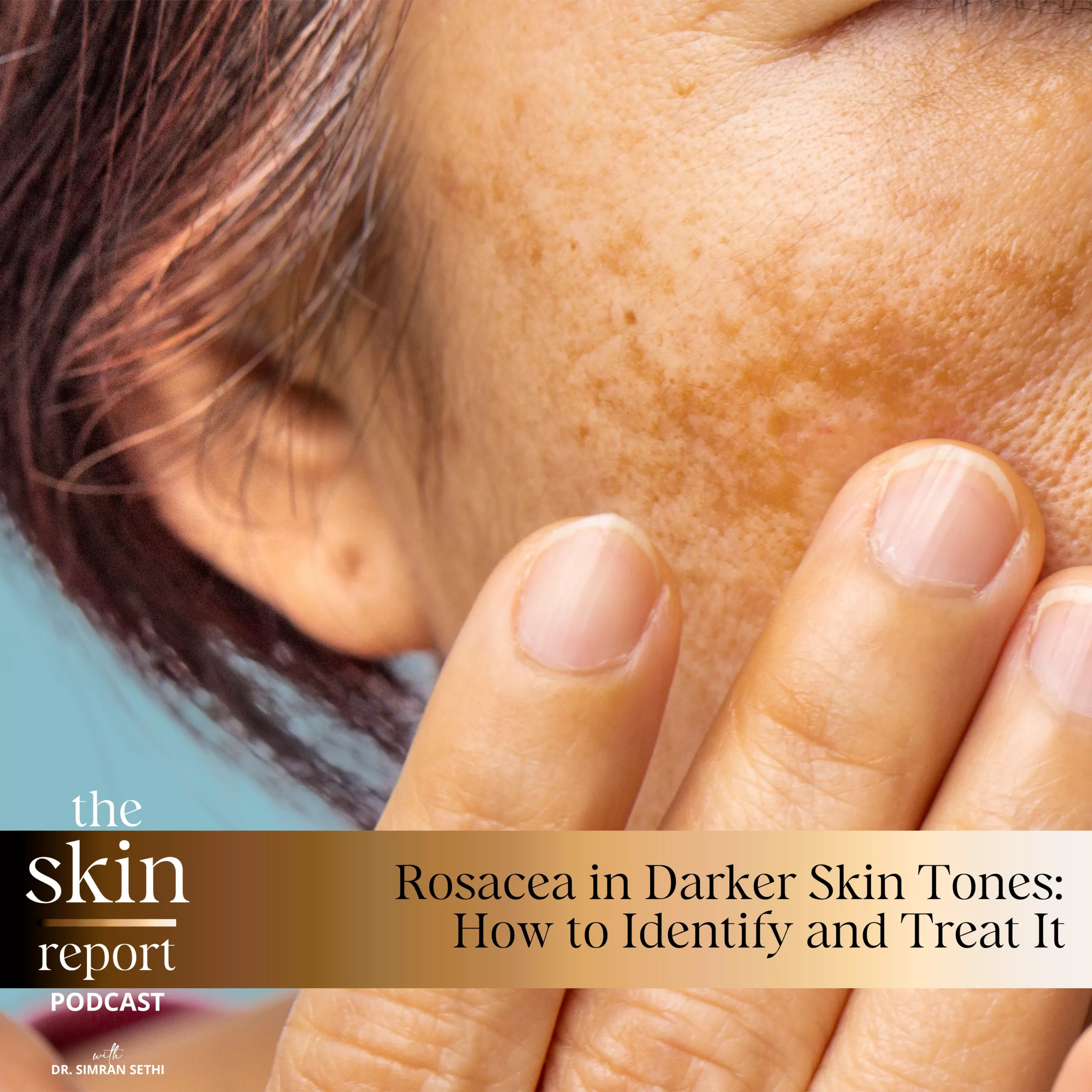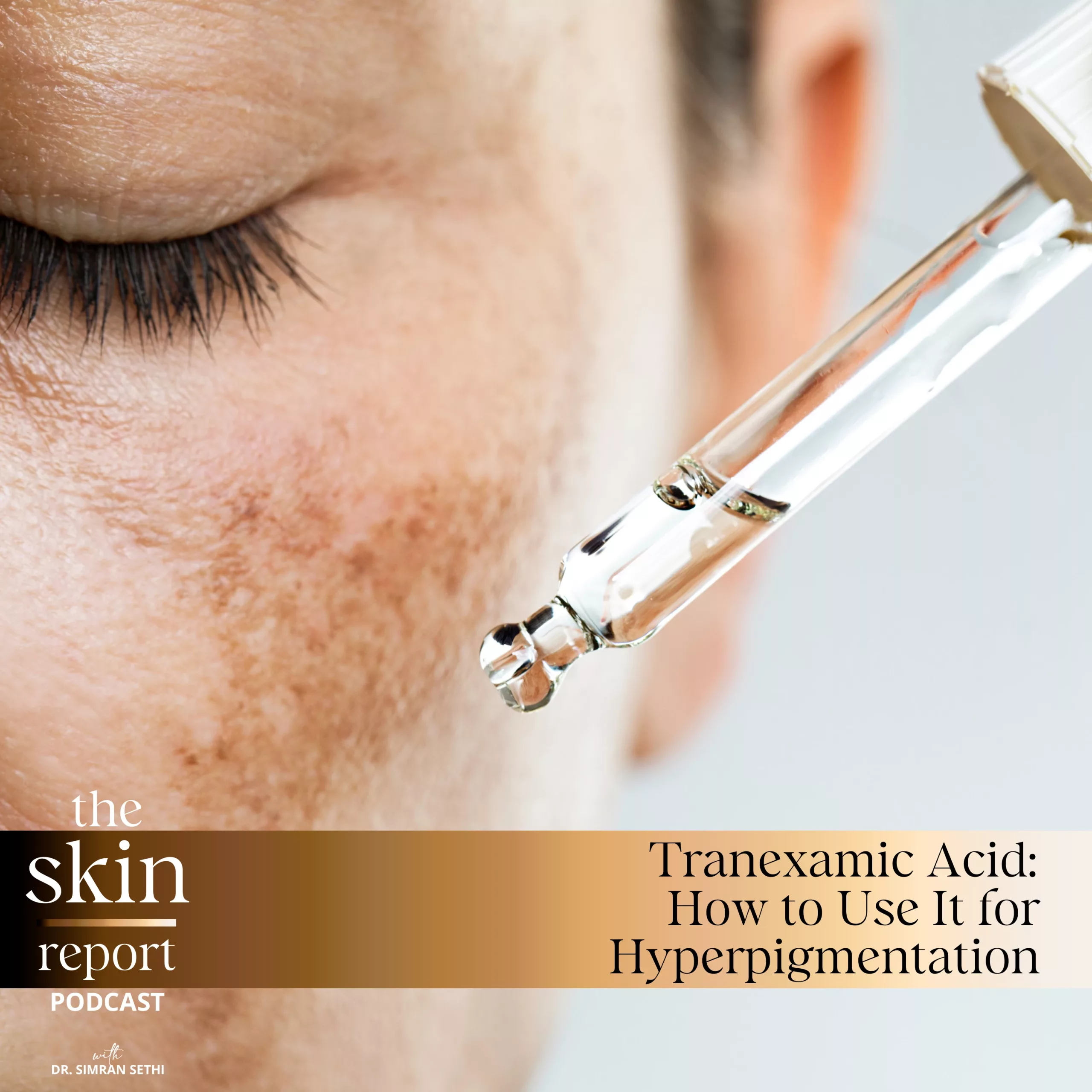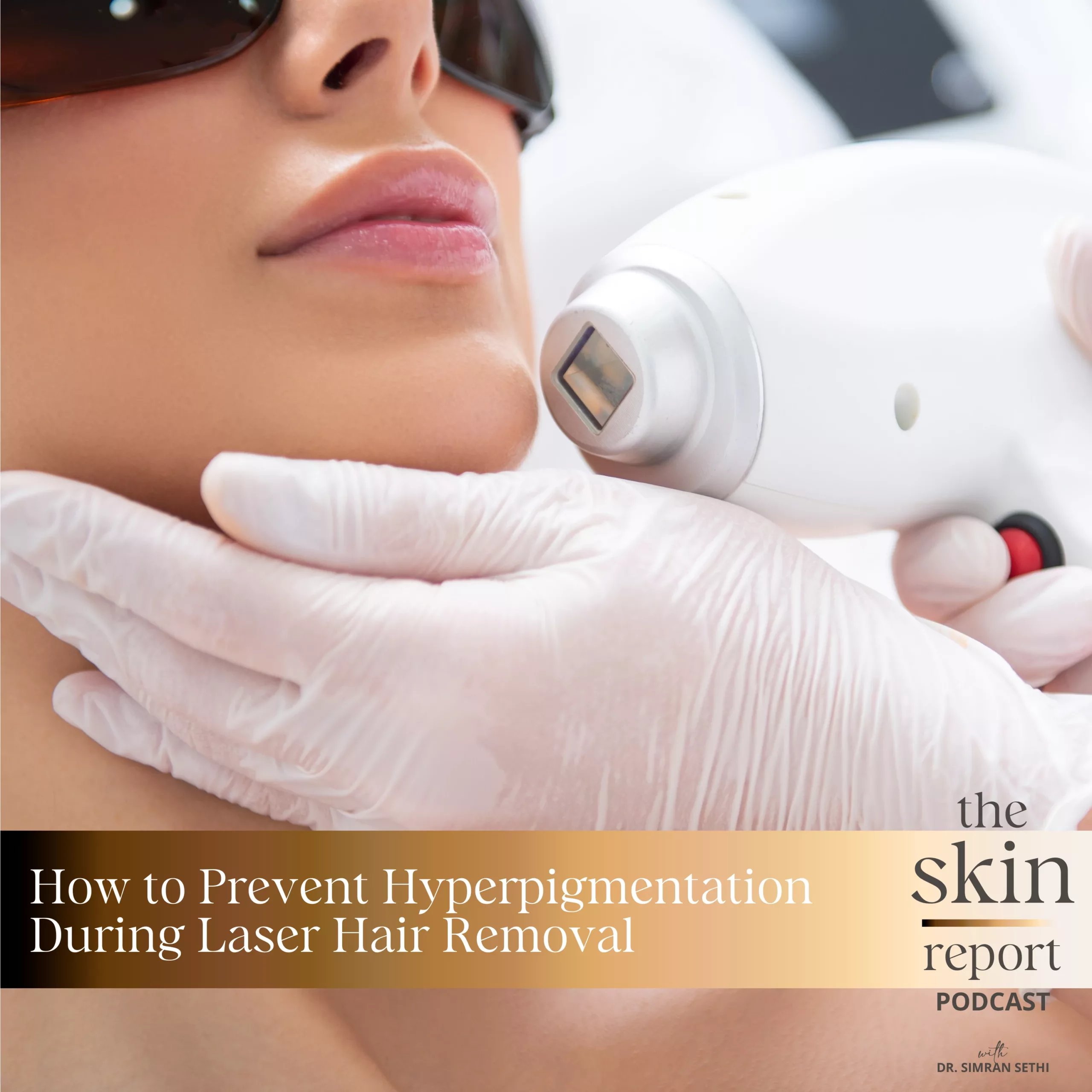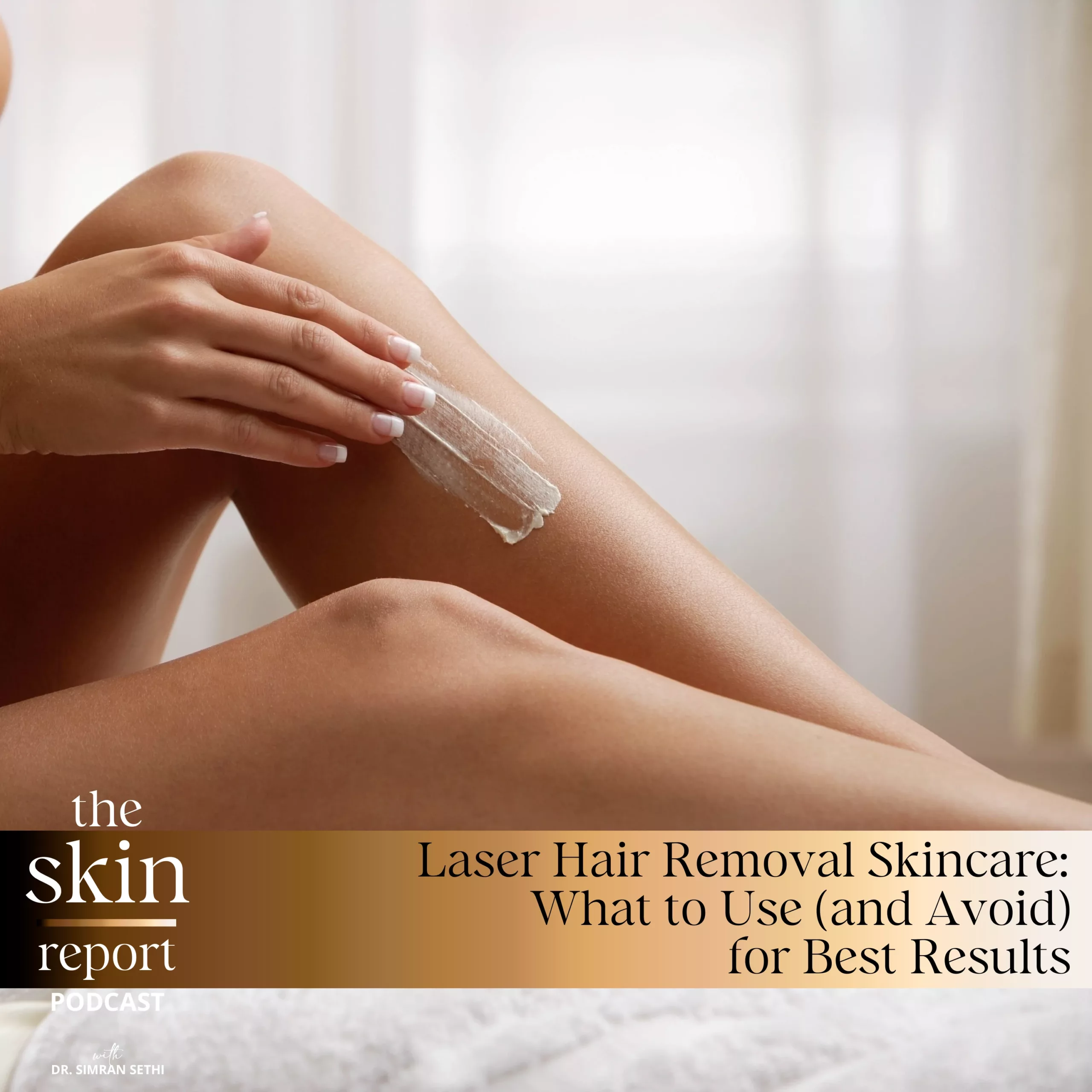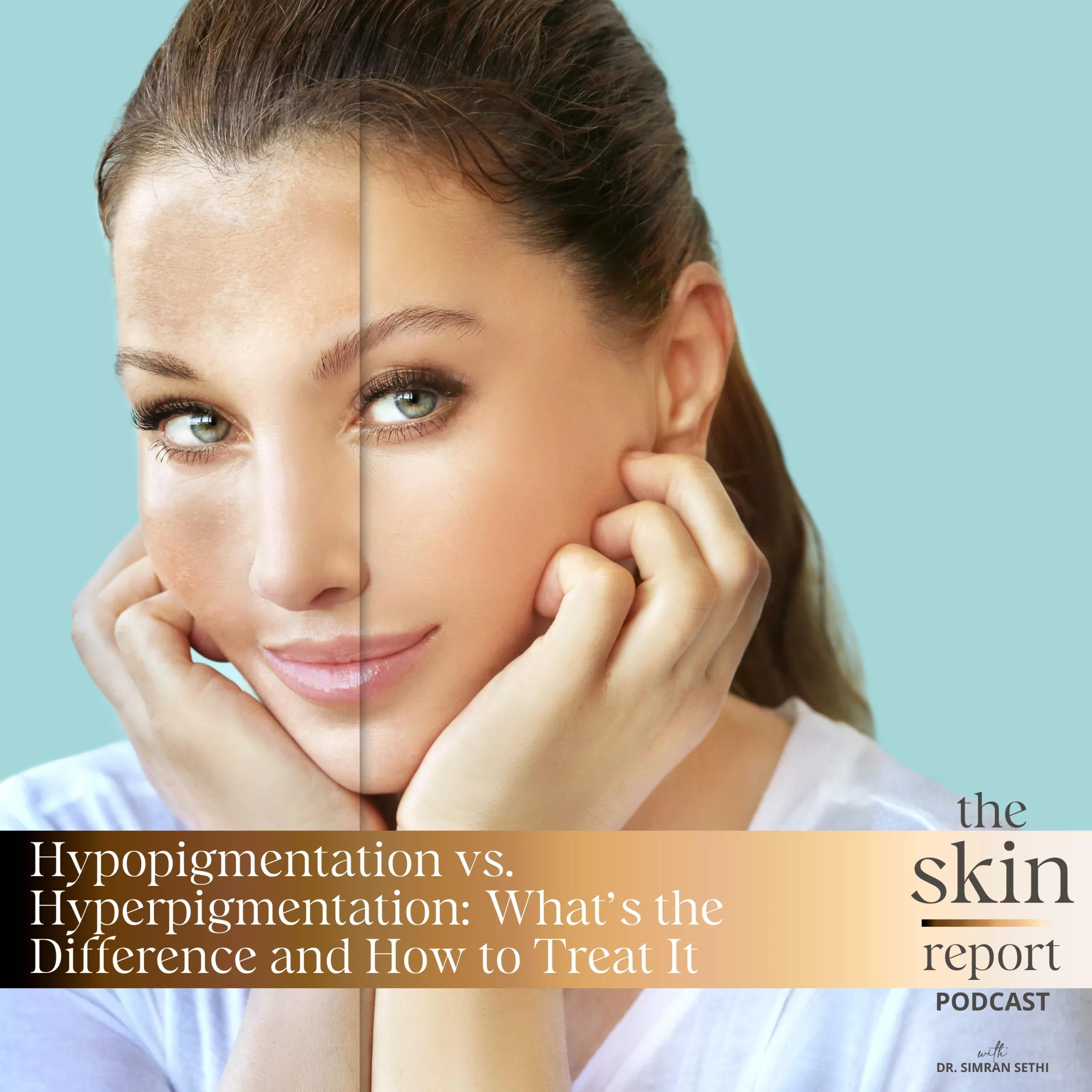Hair is an important part of our lives. Hair protects us and keeps us warm as a physical trait, but hair also has social and cultural significance that helps us represent ourselves and feel beautiful. Unfortunately, hair loss can be a painful experience that can cause one to feel like they are losing part of their identity and confidence. So what hair loss treatment can help men maintain their hair growth?
The Skin Report is a podcast created to educate listeners on methods to improve skin health for people of all ethnicities and ages. This week, host Dr. Sethi discusses hair loss in men and hair restoration. She explains the common hair loss causes and sheds light on the usefulness of PRP hair restoration in treating hair loss. PRP hair treatments, or Plasma-rich Platelet therapy, is commonly used to treat male pattern baldness and hair loss in men. She also shares how PRP hair restoration works and who will most likely benefit from this treatment method. And stay tuned – as next week’s episode will cover hair loss in women!
Follow and DM a question for Dr. Sethi to answer on The Skin Report Podcast:
RenewMD Beauty Instagram: https://www.instagram.com/renewmd_beauty/
RenewMD Beauty Medical Spas, California: https://renewmdwellness.com/
This transcript was exported on November 22, 2022 -view latest version here.
Skincare can sometimes feel overwhelming. Whether it’s finding the right products, ingredients or treatments, there’s a lot out there, but not all of it’s for people of African, Hispanic, Middle Eastern and Eastern South Asian descent. That’s why I set out to educate myself and others so that we can all feel beautiful in our skin. Hello, and welcome to the Skin Report. I’m Dr. Simran Sethi, an internal medicine doctor, mom of three, and CEO and founder of ReNewMD Medical Spas and Skin by Dr. Sethi.
For the month of November, we tackled skincare trends and hot topics, either giving them credit or kicking them to the curb. This is our first episode in December, and yes, it’s that time of the year, so if you would like to hear more about skincare gifts which are worth buying, check out last week’s episode. For today, I will be tackling a listener question on hair loss and restoration in men. Next week, we’ll be tackling hair loss in women. Stay tuned to hear more about the different ways hair loss can occur and what we can do to treat it, because there are treatments.
Hair is such an integral part of the human experience. Not only is it a physical trait, but it often has such complex social and cultural dynamics surrounding it. From a biological standpoint, hair is impressive. The average person has about 100,000 hairs. It is the fastest growing tissue in the human body, with an average growth of 35 meters per day. It is completely natural and normal to lose between 50 to 100 hairs a day. However, when we lose large amounts of hair, it can be such a painful experience. We may feel like we’re losing part of our identity, heritage, and even beauty.Hair loss goes beyond just aging. Like our skin, our hair can sometimes be a reflection of our overall health. I received a listener question around this very topic by a man named Eddie. Today, I’d like to spend the episode explaining why hair loss occurs, particularly for men, and how we can approach restoration treatments, particularly plasma-rich platelet therapy. Eddie stated that he is 60 years old and is wondering if PRP hair restoration is an option for him.
First, let’s start with the most common cause of hair loss in men. Androgenetic alopecia, also called male pattern baldness, is the leading cause and is influenced by hormones and genetics. A study published the National Library of Medicine found that more than 50% of men over the age of 50 will experience male pattern baldness to some extent. We’re not sure why men experience more hair loss than women, but know that it may be related to having higher levels of testosterone than women. This may seem daunting, but we will spend more time discussing this and possible therapies later in the episode. The second most common cause of hair loss in both men women is stress. Luckily, it is also the most treatable and responsive to PRP hair treatments.
While less common, hypothyroidism can thin hair and it’s certainly something that people should be evaluated for. Nutritional deficiencies can also cause hair loss. It’s less common in the modern world, but often when someone is on a very calorie restricted diet to lose weight, it can occur. Iron deficiency is a common nutritional deficiency that is prevalent in menstruating women who are also vegetarian. However, if you have iron deficiency, you should first get evaluated for the cause of the deficiency and make sure it’s not related to something more dangerous like colon cancer, as it is frequently the first sign of a colon lesion. When we return, we’ll return to Eddie’s question about plasma rich platelets or PRP.
Just to recap, Eddie asks if at 60 years old PRP was still possible for him, but what is PRP exactly? Plasma-rich platelet therapy has been utilized for the treatment of male and female pattern hair loss. PRP therapy essentially delivers growth factors directly to the hair follicles to help with activating them into their growth phase. Hair follicles have different phases of growth. Roughly 90% of hair is in its antigen phase or growth phase, the remaining are in a transition or resting phase before falling out. In hair loss, a hair follicle remains in its dormant state and does not produce hair growth. PRP can help push a hair follicle into an active growth phase, but if the hair follicle has remained dormant for too long, it will have limited or no response to PRP.
When I’m assessing someone for PRP hair restoration, I always ask the following questions. When did the hair loss start? Do you have any male relatives with hair loss? Do you have hypothyroidism or any thyroid issue that you know of? Have you been experiencing any stress lately? Are you on a diet? I’m going to go through each question to show what different answers may tell me about the cause of the hair loss and if PRP will help restore it.
When did the hair loss start? If hair loss has been more gradual, then androgenetic alopecia is more likely the culprit. If the hair loss happens more acutely, then there may be another cause. Do you have any male relatives with hair loss? This is a very important question, as 80% of males with androgenetic hair loss have a first degree male relative with hair loss. The age of hair loss of that relative is also an important factor. If the hair loss was in their younger years, as in mid twenties to thirties, this makes the genetic stimulus for hair loss even stronger.
Do you have hypothyroidism or any thyroid issues that you know of? Low production of thyroid hormone can lead to hair loss, but this is accompanied by unexplained weight gain, constipation and a few other symptoms. If the patient has any symptoms suggestive of thyroid disease, I start evaluating that first, as correction of the thyroid issue will return hair back to its normal growth and thickness.
Have you been experiencing any stress lately? You will be shocked at how many people lose their hair due to stress. Stress-related hair loss usually occurs over the course of a year, so it’s more acute. If the stressor is reduced, this kind of hair loss responds very well to PRP hair restoration treatments. In most cases, you do need PRP to restore all your hair growth back because usually even when the stressor is gone, all the hair growth does not return or it takes a good year or more to return. This is where PRP is very helpful. PRP will ensure that all hair growth returns after the stressor is gone and returns in a few short months.
Are you on a diet? Sometimes very strict calorie restriction can cause hair loss. I’m not suggesting that all diets or calorie deficits cause hair loss, but those that are very limiting, like ones that allow less than 1,000 calories a day, will not have enough nutrients for normal hair growth. Again, PRP will help all your normal hair growth return once essential nutrients have been added back to the diet.
Now, you’re probably wondering if improving your diet will make all the hair come back, which means there won’t be any need for PRP treatments. While there will be significant recovery of hair growth after nutrients are added back to the diet, full recovery still needs at least four to six PRP treatments. I know this because I see a good number of patients who have waited a whole year after improving their diet but have not seen all their hair growth come back. After doing PRP treatments on them, they respond well and have full hair growth in six months.
If you’d like to hear if PRP is possible for you and what that may look like, stick around after the break.
In addition to the questions that I just asked and answered, there’s another aspect I must assess before considering PRP, the extent of the hair loss. If there’s absolutely no hair growth in an area and the scalp is shiny, in men with androgenetic hair loss, PRP is not an option. Those hair follicles have been dormant for too long and will not respond to PRP hair restoration. If there’s moderate to significant hair loss or thinning, but the scalp is not shiny those areas, PRP is an option.When men with complete hair loss see me in my office, I ask them to explore hair transplantation and explain that PRP is a great way to improve the results of transplantation in the future if they decide to go that route. I do not perform hair transplants, so it wouldn’t be fair for me to discuss who the right candidates for that are, but I know that PRP has a window of opportunity. The earlier you explore it, the more successful it will be.
PRP can be delivered with two methods, either by injecting small needles directly into the scalp or by creating microchannels in the scalp with a procedure called microneedling and then dropping the PRP into those channels. Microneedling is a minimally invasive treatment that uses thin needles to make small punctures deep into the scalp where PRP is then delivered. I will explain this process in greater detail next. Before explaining how I implement PRP therapy via microneedling, I want to explain why I take this approach. In fact, I only microneedle PRP to the scalp as it is significantly more comfortable than small injections. Additionally, microneedling delivers the same amount of PRP as injecting it. Injecting PRP directly into the scalp is also effective, but is very uncomfortable.
Microneedling with PRP, what is that like? In my office, we numb the scalp with a prescription grade numbing cream for 30 to 45 minutes, then draw the patient’s blood. We spin the blood sample in a centrifuge to separate out their plasma, which is what contains the platelets. Platelets bring with them activating growth factors, which when we put into the scalp will stimulate follicle growth. We then wash off the numbing cream and then use our microneedling device, which is essentially a motorized device with 14 needles in it, a new set of needles for each patient of course, that go as deep as two and a half millimeters into the scalp. This process creates microchannels into the scalp where we then apply the patient’s PRP to deliver it to their hair follicle.
How often should this be done? We’ll answer that when we return.
A common question I receive with PRP, as with almost any procedure, is how often should I get treatments? Patients will start noticing hair growth after about two treatments, but full results will take a good four to six sessions. If your hair loss is from androgenetic alopecia, then I recommend doing maintenance PRP treatments. Generally, after completion of the first set of sessions, I will do a PRP treatment three months later, then six months later, and always suggest doing at least one PRP hair treatment every six months, which means two treatments a year.
Now, I generally don’t go into pricing our treatments or products, but I do want to give you some idea of the range of pricing for these treatments as it will help you make better choices as a consumer. If someone is charging a too good to be true price, knowing market pricing ranges helps identify clinics that may not be offering the right procedure or product. PRP hair restoration treatments range between $800 to $1,000 per session, which means a treatment package is usually between $3,600 to $4,000. If you see prices less than that, the clinic is likely using equipment that does not effectively extract PRP, which will definitely limit treatment results and be a waste of your money. I hope that having some idea of pricing will help you determine the right practitioner for you.
Battling against hair loss can sometimes feel futile, but I’ve seen some great results. Essentially, the amount of hair loss and cause of it determines whether PRP will be successful or not. It is an excellent treatment if performed on the right patient. Eddie, I hope that this helps answer your question. If you have a specific skin or hair care question, you can message me at theskinreportbydrsethi.com. On this site you can even leave a voice message, which we will then play in our episode.
If you’d like to learn more about science-backed skincare or medical aesthetic treatments, please subscribe to and turn on notifications for The Skin Report so you always know when a new episode is up. We have a newsletter that you can sign up for on theskinreportbydrsethi.com so that you can stay up to date on all our new episodes, blogs, products and more. Additionally, if you have a skincare question or want to make an episode topic recommendation, please message me at theskinreportbydrsethi.com. We’ve received some great questions so far and I’ll try and answer them at the end of every episode, so keep them coming. Thanks for listening, and until next time, love the skin you’re in and celebrate your beauty.
Transcript by Rev.com



